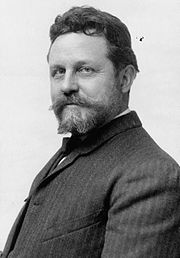William H. Rau
| William H. Rau | |
|---|---|

Rau, photographed by J.C. Strauss in 1904
|
|
| Born |
January 19, 1855 Philadelphia, Pennsylvania |
| Died | November 19, 1920 (aged 65) Philadelphia, Pennsylvania |
| Spouse(s) | Louisa Bell |
| Parent(s) | Peter Rau and Mary Witschi |
| Relatives | William Bell (father-in-law) |
William Herman Rau (January 19, 1855 – November 19, 1920) was an American photographer, active primarily in the latter half of the 19th and early 20th centuries. He is best remembered for his stereo cards of sites around the world, and for his panoramic photographs of sites along the Pennsylvania Railroad. He was official photographer of the St. Louis World's Fair in 1904, and of the Lewis and Clark Centennial Exposition in Portland in 1905. His work is now included in the collections of the Smithsonian Institution and the Getty Museum.
Rau was born in Philadelphia in 1855, the son of German and Swiss immigrants Peter and Mary Witschi Rau. His older brother, George, operated a photography studio out of the Rau house, and William picked up the trade while still young. At the age of 13, he started doing photographic work for his future father-in-law, William Bell, who was a medical and survey photographer for the federal government.
In 1874, with Bell's recommendation, Rau joined an expedition to Chatham Island in the South Pacific to photograph the Transit of Venus. Sailing along the sloop Swatara, Rau photographed some of the world's most remote places while on this expedition. He was less successful in capturing the transit itself, however, after his tent caught fire, and cloudy skies obscured most of the transit. None of Rau's photographs of the transit were sharp enough to be of use to scientists.
After returning, Rau joined the Centennial Photographic Company, which had been set up by photographer and publisher Edward L. Wilson to conduct photographic work for Philadelphia's Centennial Exposition of 1876. After the exposition, he joined his father-in-law's stereo card studio, which he purchased in 1878. He operated this studio in partnership with his brother, George, until 1880.
...
Wikipedia
